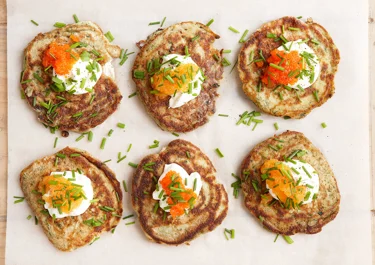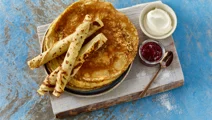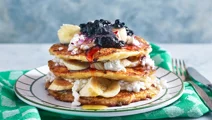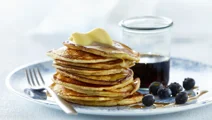Thin Russian pancake

Discover the delicate textures and rich flavours of thin Russian pancakes, a traditional favourite with a twist. Crafted with spinach and buckwheat flour, this recipe is ideal for an elegant breakfast or a stylish brunch. Paired with savoury toppings like sour cream, chives, and whitefish roe, these light and airy pancakes beautifully balance the earthy notes of buckwheat, delivering a unique and satisfying culinary experience.
Ingredients
|
1
Egg
|
|
|---|---|
|
150 ml
Milk
|
|
|
4 g
Dry yeast
|
|
|
105 g
Plain flour
|
|
|
50 g
Buckwheat flour
|
|
|
Salt (pinch)
|
|
|
50 g
Frozen chopped spinach
|
|
|
Butter (for frying)
|
To serve
|
100 ml
Sour cream
|
|
|---|---|
|
20 g
Chopped fresh chives
|
|
|
95
Whitefish roe
|
Instructions
Recommended information
Serving suggestion
Make perfectly round and thin Russian pancakes
While this can take a bit of practice, you can achieve restaurant-quality results with the right technique. Start by using a consistent amount of batter for each pancake. A small ladle, cookie scoop, or measuring cup works well for portioning. Pour the batter steadily into the centre of the pan without spreading it manually, allowing it to naturally form a circular shape. For added precision, you can use a lightly greased pancake or egg ring to contain the batter. Cooking one at a time in a flat, non-stick pan also helps prevent irregularities.
No whitefish roe? No problem!
If you don’t have whitefish roe on hand, there are plenty of other toppings that pair beautifully with these delicate pancakes. Try using other types of fish roe, such as trout or salmon, for a similar texture and burst of flavour. Alternatively, finely chopped smoked salmon can be a delicious substitute. For a vegetarian twist, consider topping them with sautéed mushrooms or a dollop of caramelised onion. Whatever you choose, pair it with a tangy topping – such as sour cream or skyr – and fresh herbs to maintain the creamy and herby balance of the dish. Looking for more inspiration? Try this blini pancake recipe with a cottage cheese cream, shrimp, and smoked salmon – a recipe that showcases the perfect harmony of flavours and textures.
Make sure the yeast is properly activated
Properly activating the yeast is essential to achieving a light and airy texture in your pancakes. Yeast produces the gas bubbles that make the batter rise, so ensuring it's alive and active is crucial. Start by warming the milk to around 37 °C, it should feel lukewarm to the touch, but not hot as excessive heat can kill the yeast. Dissolve the granules into the milk and stir gently. Let the mixture sit for 5-10 minutes, watching for bubbles or foam on the surface, a clear sign that the yeast is active and ready to work its magic. Using fresh yeast and following these steps will help ensure your pancakes rise perfectly and have the ideal fluffiness.
FAQ: Questions about thin Russian pancakes
Explore the art of making this recipe with our helpful FAQ section. If you're curious about preparation techniques, storage tips, or serving suggestions, our answers will guide you to master this delightful classic with a twist. Read on to ensure your pancakes turn out perfect.
How can I prevent my batter from curdling?
To prevent curdling, it’s essential to avoid mixing ingredients with different temperatures too quickly. In this recipe, the warm milk used to activate the yeast can cause curdling if combined abruptly with colder ingredients like eggs. To avoid this, let all ingredients come to room temperature before mixing, or gradually temper them. For example, when adding warm milk to the batter, pour it in slowly while whisking continuously to ensure the temperatures blend smoothly. This method creates a cohesive consistency, helping your thin Russian pancakes achieve a light, airy texture without any curdling issues.
Why are my thin Russian pancakes soggy?
Soggy pancakes are often caused by cooking at too low a temperature or using too much fat in the pan. Ensure your pan is evenly preheated over medium heat before adding a small amount of butter – just enough to coat the surface lightly. If the pan isn’t hot enough, they may absorb excess butter, resulting in a greasy and soggy texture. Cook each one until the edges are golden and the surface is dry, flipping only when the underside is lightly browned. Also avoid stacking freshly cooked pancakes directly on top of each other, as the trapped steam can make them soggy. Instead, place them in a single layer on a wire rack or baking sheet in a low oven (about 100 °C) to keep them warm and crisp until ready to serve.
Can the batter be prepared in advance?
Yes, you can prepare the batter in advance, but proper storage is essential to maintain its texture. After the initial rise, cover the batter tightly with cling film or an airtight lid and refrigerate for up to 12 hours. Before cooking, allow the batter to come back to room temperature, as cold batter may not cook evenly. Gently stir in the thawed spinach, making sure to also redistribute any settled ingredients. Take care not to overmix, which can deflate the rise. Keep in mind that refrigeration slows yeast activity, so the batter might need an additional 10-15 minutes at room temperature to regain its optimal consistency.
Master the art of whipping egg whites
Whipping egg whites to stiff peaks is crucial for giving these thin Russian pancakes their light and airy texture. Start with a clean, dry bowl and whisk to ensure no grease or residue interferes with the process. Use room-temperature egg whites for the best volume. Begin whisking on a low speed to create small, stable bubbles, then gradually increase the speed until the whites hold stiff peaks.
Gently fold the whipped whites into the batter, taking care not to deflate them, as this step contributes to the pancakes’ fluffiness.
Switch to skyr for a unique flavour
Elevate this recipe by swapping the traditional sour cream with skyr for a fresh twist. Skyr’s creamy texture and mild tanginess add a unique depth of flavour that perfectly complements the pancakes’ delicate structure. Its higher protein content also gives your dish a welcome boost while maintaining a luxurious consistency. For the best experience, choose plain skyr, and serve it as a topping with the roe and chives.
Use multiple skillets for efficient cooking
If you’re making thin Russian pancakes for a crowd, using multiple skillets can speed up the cooking process and ensure they stay warm and fresh. Heat two or three pans simultaneously on separate burners, adding a small amount of butter to each before cooking. Rotate between the skillets, pouring batter into one while another pancake finishes cooking. This method saves time and ensures that everyone at the table gets to enjoy hot appetisers at the same time.
Get the buckwheat batter consistency just right
The consistency of your batter is key to making thin Russian pancakes. It should be pourable but not watery, thick enough to coat the back of a spoon without clumping. If it feels too thick after the first rise, add a small splash of milk to loosen it. Conversely, if it’s too thin, mix in a teaspoon of buckwheat flour at a time, letting it sit for a few minutes to absorb the liquid. Adjusting the consistency before cooking will help you achieve perfectly thin, even pancakes.
Expert techniques for proper browning
Achieving the perfect golden-brown colour requires attention to heat and timing. Begin by preheating your pan over medium heat to ensure even cooking. Add a small amount of butter or oil to coat the surface lightly – too much fat can make the blini greasy rather than crisp.
Pour a small amount of batter into the pan and watch closely: the key is to cook slowly enough that the edges turn golden while the centre cooks through. Flip only when bubbles form on the surface and the underside is a uniform golden brown. Avoid pressing down after flipping, as this can interfere with the airy texture.
For consistent results, wipe the pan lightly with a paper towel between batches to remove excess butter or residue, maintaining an even cooking surface. These tips will give you evenly browned, crispy and perfectly thin Russian pancakes every time.









